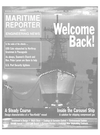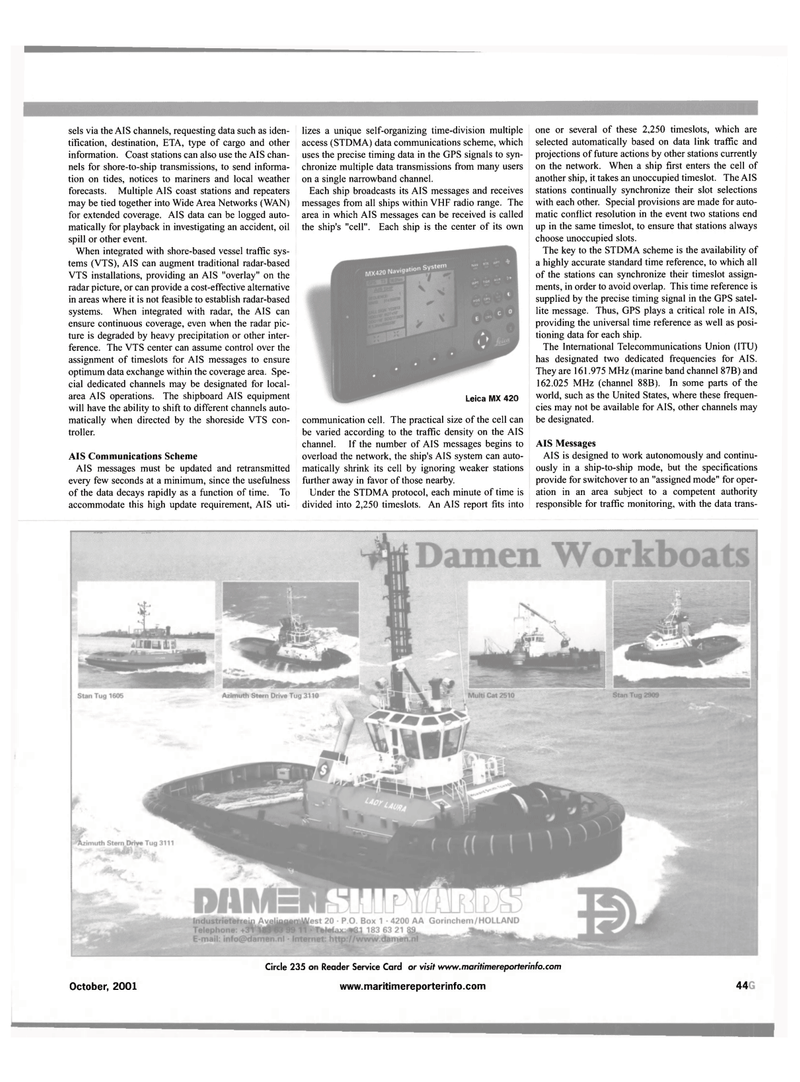
Page 51: of Maritime Reporter Magazine (October 2001)
Read this page in Pdf, Flash or Html5 edition of October 2001 Maritime Reporter Magazine
sels via the AIS channels, requesting data such as iden- tification, destination, ETA, type of cargo and other information. Coast stations can also use the AIS chan- nels for shore-to-ship transmissions, to send informa- tion on tides, notices to mariners and local weather forecasts. Multiple AIS coast stations and repeaters may be tied together into Wide Area Networks (WAN) for extended coverage. AIS data can be logged auto- matically for playback in investigating an accident, oil spill or other event.
When integrated with shore-based vessel traffic sys- tems (VTS), AIS can augment traditional radar-based
VTS installations, providing an AIS "overlay" on the radar picture, or can provide a cost-effective alternative in areas where it is not feasible to establish radar-based systems. When integrated with radar, the AIS can ensure continuous coverage, even when the radar pic- ture is degraded by heavy precipitation or other inter- ference. The VTS center can assume control over the assignment of timeslots for AIS messages to ensure optimum data exchange within the coverage area. Spe- cial dedicated channels may be designated for local- area AIS operations. The shipboard AIS equipment will have the ability to shift to different channels auto- matically when directed by the shoreside VTS con- troller.
AIS Communications Scheme
AIS messages must be updated and retransmitted every few seconds at a minimum, since the usefulness of the data decays rapidly as a function of time. To accommodate this high update requirement, AIS uti- lizes a unique self-organizing time-division multiple access (STDMA) data communications scheme, which uses the precise timing data in the GPS signals to syn- chronize multiple data transmissions from many users on a single narrowband channel.
Each ship broadcasts its AIS messages and receives messages from all ships within VHF radio range. The area in which AIS messages can be received is called the ship's "cell". Each ship is the center of its own
Leica MX 420 communication cell. The practical size of the cell can be varied according to the traffic density on the AIS channel. If the number of AIS messages begins to overload the network, the ship's AIS system can auto- matically shrink its cell by ignoring weaker stations further away in favor of those nearby.
Under the STDMA protocol, each minute of time is divided into 2,250 timeslots. An AIS report fits into one or several of these 2,250 timeslots, which are selected automatically based on data link traffic and projections of future actions by other stations currently on the network. When a ship first enters the cell of another ship, it takes an unoccupied timeslot. The AIS stations continually synchronize their slot selections with each other. Special provisions are made for auto- matic conflict resolution in the event two stations end up in the same timeslot, to ensure that stations always choose unoccupied slots.
The key to the STDMA scheme is the availability of a highly accurate standard time reference, to which all of the stations can synchronize their timeslot assign- ments, in order to avoid overlap. This time reference is supplied by the precise timing signal in the GPS satel- lite message. Thus, GPS plays a critical role in AIS, providing the universal time reference as well as posi- tioning data for each ship.
The International Telecommunications Union (ITU) has designated two dedicated frequencies for AIS.
They are 161.975 MHz (marine band channel 87B) and 162.025 MHz (channel 88B). In some parts of the world, such as the United States, where these frequen- cies may not be available for AIS, other channels may be designated.
AIS Messages
AIS is designed to work autonomously and continu- ously in a ship-to-ship mode, but the specifications provide for switchover to an "assigned mode" for oper- ation in an area subject to a competent authority responsible for traffic monitoring, with the data trans-
October, 2001
Circle 235 on Reader Service Card or visit www.maritimereporterinfo.com www.maritimereporterinfo.com 44C

 50
50

 52
52
